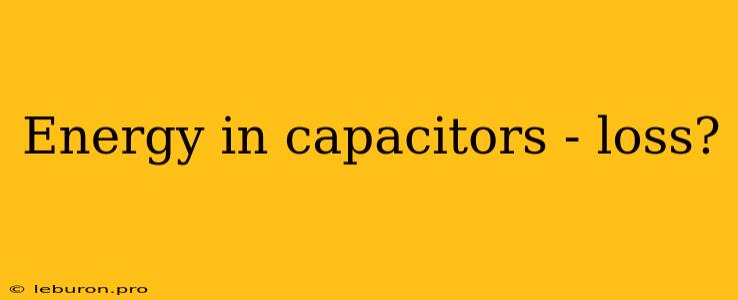Capacitors are essential components in electronic circuits, serving as energy storage devices. Their ability to store electrical energy is crucial for various applications, from filtering power supplies to powering flash lamps in cameras. However, while capacitors excel at storing energy, they are not perfect and experience some energy loss during charging and discharging cycles. Understanding the factors that contribute to energy loss in capacitors is vital for efficient circuit design and optimization.
Understanding Energy Storage in Capacitors
Capacitors store energy in the form of an electric field between their plates. When a voltage is applied across a capacitor, charges accumulate on its plates, creating an electric field. The amount of energy stored in a capacitor is directly proportional to the capacitance and the square of the voltage:
Energy (E) = 1/2 * C * V^2
Where:
- E is the energy stored in joules
- C is the capacitance in farads
- V is the voltage across the capacitor in volts
Sources of Energy Loss in Capacitors
While capacitors are designed to store energy efficiently, several factors can lead to energy loss during charging and discharging cycles. These losses can significantly impact the overall efficiency of circuits employing capacitors.
1. Dielectric Loss
Dielectric materials are used to separate the capacitor plates. These materials have a finite resistance, leading to energy dissipation as heat when an electric field is applied. This loss is known as dielectric loss and is primarily caused by:
- Polarization: The dielectric material's constituent molecules align with the electric field, causing energy dissipation due to friction.
- Conduction: Some leakage current flows through the dielectric material, causing energy loss as heat.
The extent of dielectric loss depends on the dielectric material's properties, including its permittivity, conductivity, and temperature.
2. ESR (Equivalent Series Resistance)
Every capacitor possesses an inherent internal resistance, known as ESR. This resistance represents the combined resistance of the capacitor's leads, plates, and dielectric material. When current flows through the capacitor, some energy is lost as heat due to the resistance of the ESR.
ESR is a significant factor in determining the efficiency of a capacitor, especially at higher frequencies. As frequency increases, the impedance of the capacitor decreases, and the influence of ESR on energy loss becomes more pronounced.
3. Leakage Current
Even in an ideal capacitor, some current can flow between its plates, known as leakage current. This current is typically very small but can still lead to energy loss. Leakage current is influenced by factors such as the dielectric material's quality, temperature, and applied voltage.
4. Capacitor Self-Discharge
Capacitors can lose charge over time even when not connected to a circuit. This phenomenon, known as self-discharge, is caused by internal leakage currents and is influenced by the capacitor's type, temperature, and age.
5. Switching Losses
When a capacitor is rapidly switched on or off, energy loss can occur due to the charging and discharging currents. These losses are more pronounced in circuits operating at high frequencies or with large voltage swings.
Minimizing Energy Loss in Capacitors
Understanding the sources of energy loss in capacitors allows for strategies to minimize them and improve circuit efficiency. Here are some key approaches:
- Choose High-Quality Capacitors: Selecting capacitors with low ESR and leakage current is crucial.
- Consider Temperature: Temperature affects dielectric properties and leakage current. Choose capacitors rated for the operating temperature range.
- Use Proper Capacitor Type: Different capacitor types are optimized for specific applications. Selecting the appropriate type for your circuit helps minimize energy loss.
- Optimize Circuit Design: Proper circuit design can minimize switching losses by selecting appropriate switching times and frequencies.
- Minimize Voltage Stress: Excessive voltage across the capacitor can increase dielectric loss. Designing the circuit to avoid high voltage spikes across the capacitor can improve efficiency.
Conclusion
Capacitors are vital components in electronic circuits, effectively storing electrical energy. However, they are not perfect energy storage devices and experience some energy loss during charging and discharging cycles. Understanding the sources of energy loss, such as dielectric loss, ESR, leakage current, self-discharge, and switching losses, is critical for designing efficient circuits. By selecting high-quality capacitors, considering temperature, using appropriate capacitor types, optimizing circuit design, and minimizing voltage stress, engineers can effectively minimize energy loss and improve the performance of their circuits.
